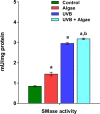Lipidomic assessment of the impact of Nannochloropsis oceanica microalga lipid extract on human skin keratinocytes exposed to chronic UVB radiation
- PMID: 38102403
- PMCID: PMC10724133
- DOI: 10.1038/s41598-023-49827-2
Lipidomic assessment of the impact of Nannochloropsis oceanica microalga lipid extract on human skin keratinocytes exposed to chronic UVB radiation
Abstract
Considerable attention has been devoted to investigating the biological activity of microalgal extracts, highlighting their capacity to modulate cellular metabolism. This study aimed to assess the impact of Nannochloropsis oceanica lipid extract on the phospholipid profile of human keratinocytes subjected to UVB radiation. The outcomes revealed that treatment of keratinocytes with the lipid extract from microalgae led to a reduction in sphingomyelin (SM) levels, with a more pronounced effect observed in UVB-irradiated cells. Concomitantly, there was a significant upregulation of ceramides CER[NDS] and CER[NS], along with increased sphingomyelinase activity. Pathway analysis further confirmed that SM metabolism was the most significantly affected pathway in both non-irradiated and UVB-irradiated keratinocytes treated with the microalgal lipid extract. Additionally, the elevation in alkylacylPE (PEo) and diacylPE (PE) species content observed in UVB-irradiated keratinocytes following treatment with the microalgal extract suggested the potential induction of pro-survival mechanisms through autophagy in these cells. Conversely, a noteworthy reduction in LPC content in UVB-irradiated keratinocytes treated with the extract, indicated the anti-inflammatory properties of the lipid extract obtained from microalgae. However, to fully comprehend the observed alterations in the phospholipid profile of UVB-irradiated keratinocytes, further investigations are warranted to identify the specific fraction of compounds responsible for the activity of the Nannochloropsis oceanica extract.
© 2023. The Author(s).
Conflict of interest statement
The authors declare no competing interests.
Figures





Similar articles
-
Restorative Effect of Microalgae Nannochloropsis oceanica Lipid Extract on Phospholipid Metabolism in Keratinocytes Exposed to UVB Radiation.Int J Mol Sci. 2023 Sep 20;24(18):14323. doi: 10.3390/ijms241814323. Int J Mol Sci. 2023. PMID: 37762626 Free PMC article.
-
Prevention of UVB Induced Metabolic Changes in Epidermal Cells by Lipid Extract from Microalgae Nannochloropsis oceanica.Int J Mol Sci. 2023 Jul 11;24(14):11302. doi: 10.3390/ijms241411302. Int J Mol Sci. 2023. PMID: 37511067 Free PMC article.
-
Nannochloropsis oceanica Lipid Extract Moderates UVB-Irradiated Psoriatic Keratinocytes: Impact on Protein Expression and Protein Adducts.Antioxidants (Basel). 2024 Oct 14;13(10):1236. doi: 10.3390/antiox13101236. Antioxidants (Basel). 2024. PMID: 39456489 Free PMC article.
-
Cannabidiol-Mediated Changes to the Phospholipid Profile of UVB-Irradiated Keratinocytes from Psoriatic Patients.Int J Mol Sci. 2020 Sep 9;21(18):6592. doi: 10.3390/ijms21186592. Int J Mol Sci. 2020. PMID: 32916896 Free PMC article.
-
Changes in Lipid Profile of Keratinocytes from Rat Skin Exposed to Chronic UVA or UVB Radiation and Topical Application of Cannabidiol.Antioxidants (Basel). 2020 Nov 25;9(12):1178. doi: 10.3390/antiox9121178. Antioxidants (Basel). 2020. PMID: 33255796 Free PMC article.
Cited by
-
The Effects of Lipid Extracts from Microalgae Chlorococcum amblystomatis and Nannochloropsis oceanica on the Proteome of 3D-Cultured Fibroblasts Exposed to UVA Radiation.Antioxidants (Basel). 2025 Apr 30;14(5):545. doi: 10.3390/antiox14050545. Antioxidants (Basel). 2025. PMID: 40427427 Free PMC article.
References
-
- Stellavato, A. et al. Positive effects against UV-A induced damage and oxidative stress on an in vitro cell model using a hyaluronic acid based formulation containing amino acids, vitamins, and minerals. BioMed Res. Int. 2018, e8481243. https://www.hindawi.com/journals/bmri/2018/8481243/ (2018). - PMC - PubMed
MeSH terms
Substances
LinkOut - more resources
Full Text Sources
Miscellaneous

